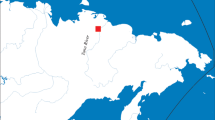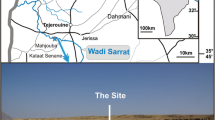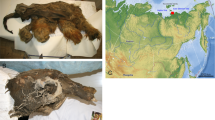Abstract—
Carcasses of mammals with well-preserved soft tissues from the permafrost of Siberia and northern North America are among the most important sources of our knowledge on Quaternary environments. However, the potential of this information source is far from being exhausted. The objective of this study is to reveal and describe the remains of freshwater invertebrates in the hair and gut contents of large Pleistocene mammals stored for a long time in museum collections. We have studied the gut contents of two mammoths, as well as the hair of two other mammoths, one woolly rhinoceros, four bison, and two horses. Remains of invertebrates were found in the gut contents of both mammoths, as well as in the hair of two mammoths and the woolly rhinoceros, while no remains were detected in the bison and horse hair. Among the remains of microscopic invertebrates, the most common are branchiopod crustaceans, namely the ephippia of Daphnia sp., Simocephalus sp., the head shields and valves of Chydoridae (Cladocera), and the mandibles of tadpole shrimps (Notostraca). Based on our current level of knowledge, we are able to identify only a limited number of Pleistocene branchiopods. Studies on Recent taxa with the aim to develop identification keys to the aforementioned groups are needed, as they could significantly expand the potential of palaeoecological analysis.



Similar content being viewed by others
REFERENCES
Barnes, I., Shapiro, B., Lister, A., Kuznetsova, T., Sher, A., et al., Genetic structure and extinction of the woolly mammoth, Mammuthus primigenius, Curr. Biol., 2007, vol. 17, pp. 1072–1075.
Benzie, J.A.H., The genus Daphnia (including Daphniopsis) (Anomopoda: Daphniidae), in Guides to the Identification of the Microinvertebrates of the Continental Waters of the World, Leiden: Kenobi Productions, Ghent and Backhuys Publishers, 2005, vol. 21.
Boeskorov, G.G., Protopopov, A.V., Mashchenko, E.N., Potapova, O.R., Kuznetsova, T.V., et al., New findings of unique preserved fossil mammals in the permafrost of Yakutia, Dokl. Biol. Sci., 2013, vol. 452, pp. 291–295.
Boeskorov, G.G., Potapova, O.R., Protopopov, A.V., Plotnikov, V.V., Kirikov, K.S., et al., The Yukagir Bison: analysis of a complete frozen mummy of the bison, Bison priscus from the early Holocene of Northern Eurasia, Quat. Int., 2016, vol. 406, pp. 94–110.
Boeskorov, G.G., Potapova, O.R., Protopopov, A.V., Plotnikov, V.V., Maschenko, E.N., et al., A study of a frozen mummy of a wild horse from the Holocene of Yakutia, East Siberia, Russia, Mammal Res., 2018, vol. 63, no. 3, pp. 307–314.
Brown, T.A. and Barnes, I.M., The current and future applications of ancient DNA in Quaternary science, J. Quat. Sci., 2015, vol. 30, pp. 144–153.
Chernova, O.F., Kirillova, I.V., Boeskorov, G.G., and Shidlovskii, F.K., Identification of hairs of the wooly mammoth Mammuthus primigenius and wooly rhinoceros Coelodonta antiquitatis using scanning electron microscopy, Dokl. Biol. Sci., 2015, vol. 463, pp. 205–210.
Cherskii, I.D., Description of the collection of post-Tertiary mammals collected by the Novosibirsk expedition in 1885–1886, Zap. Imper. Akad. Nauk, 1891, vol. 65, suppl. 1, pp. 1–734.
Fedorov, S.E., The history of research of the Quaternary mammals in Yakutia (18th–20th centuries), Cand. Sci. (Biol.) Dissertation, Yakutsk: Sev.-Vost. Fed. Univ. im. M.K. Ammosova, 2017.
Flerov, K.K., Bisons of North-Eastern Siberia, Tr. Zool. Inst. Akad. Nauk SSSR, 1977, vol. 73, pp. 39–56.
Garutt, N.V. and Boeskorov, G.G., Woolly rhinoceros: the history of the genus, in Mamont i ego okruzhenie: 200 let izucheniya (Mammoth and Its Environment: 200 Years of Research), Rozanov, A.Yu., Ed., Moscow: GEOS, 2001, pp. 157–167.
Van Geel, B., Fisher, D.C., Rountrey, A.N., Van Arkel, J., Duivenvoorden, J.F., et al., Palaeo-environmental and dietary analysis of intestinal contents of a mammoth calf (Yamal Peninsula, Northwest Siberia), Quat. Sci. Rev., 2011, vol. 30, pp. 3935–3946.
Glamazdin, I.G., Serdyuk, N.V., Panova, O.A., Tikhonov, A.N., and Mashchenko, E.N., Parasitological studies of organs and tissues of the Sopkarga mammoth (M. primigenius) (Taimyr, Russia), Teor. Prakt. Bor’by Parazit. Bol., 2014, no. 15, pp. 73–76.
Gorlova, R.N., Plant macrofossils found in the gastrointestinal tract of the Yuribey mammoth, in Yuribeiskii mamont (Yuribey Mammoth), Sokolov, V.E., Eds., Moscow: Nauka, 1982, pp. 37–43.
Guil-Guerrero, J.L., Rodríguez-García, I., Kirillova, I., Shidlovskiy, F., Ramos-Bueno, R.P., et al., The PUFA-enriched fatty acid profiles of some frozen bison from the Early Holocene found in the Siberian Permafrost, Sci. Rep., 2015, vol. 5. e7926.
Guthrie, R.D., Frozen Fauna of the Mammoth Steppe: The Story of Blue Babe, Chicago, London: The University of Chicago Press, 1990.
Kirillova, I.V., Zanina, O.G., Kosintsev, P.A., Kul’kova, M.A., Lapteva, E.G., et al., The first finding of a frozen Holocene bison (Bison priscus Bojanus, 1827) carcass in Chukotka, Dokl. Biol. Sci., 2013, vol. 452, pp. 296–299.
Kirillova, I.V., Kotov, A.A., Trofimova, S.S., Zanina, O.G., Lapteva, E.G., et al., Fossil fur as a new source of information on the Ice Age biota, Dokl. Biol. Sci., 2015, vol. 460, pp. 48–51.
Kirillova, I.V., Zanina, O.G., Chernova, O.F., Lapteva, E.G., Trofimova, S.S., et al., An ancient bison from the mouth of the Rauchua River (Chukotka, Russia), Quat. Res., 2015a, vol. 84, pp. 232–245.
Kirillova, I.V., Argant, J., Lapteva, E.G., Korona, O.M., Van der Plicht, J., et al., The diet and environment of mammoths in North-East Russia reconstructed from the contents of their feces, Quat. Int., 2016, vol. 406, pp. 147–161.
Kirillova, I.V., Van der Plicht, J., Gubin, S.V., Zanina, O.G., Chernova, O.F., et al., Taphonomic phenomenon of ancient hair from Glacial Beringia: perspectives for palaeoecological reconstractions, Boreas, 2016a, vol. 45, no. 3, pp. 1–15.
Kirillova, I.V. and Shidlovskii, F.K., Aberrant remains of a woolly mammoth in the collection of the Museum of Ice Age, Tr. Zool. Inst. Ross. Akad. Nauk, 2018, vol. 322, no. 3, pp. 285–305.
Kosintsev, P.A., Lapteva, E.G., Trofimova, S.S., Zanina, O.G., Tikhonov, A.N., et al., The intestinal contents of a baby woolly mammoth (Mammuthus primigenius Blumenbach, 1799) from the Yuribey River (Yamal Peninsula), Dokl. Biol. Sci., 2010, vol. 432, pp. 209–211.
Kosintsev, P.A., Lapteva, E.G., Korona, O.M., and Zanina, O.G., Living environments and diet of the Mongochen mammoth, Gydan Peninsula, Russia, Quat. Int., 2012, vols. 276–277, pp. 253–268.
Kosintsev, P.A., Lapteva, E.G., Trofimova, S.S., Zanina, O.G., Tikhonov, A.N., and van der Plicht, J., Environmental reconstruction inferred from the intestinal contents of the Yamal baby mammoth Lyuba (Mammuthus primigenius Blumenbach, 1799), Quat. Int., 2012a, vol. 255, pp. 231–238.
Kotov, A.A., Zharov, A.A., Chernova, O.F., Neretina, A.N., Gololobova, M.A., et al., Crustacea (Branchiopoda) among organic remains from mammoth hair, Biol. Bull. (Moscow), 2019, vol. 46, no. 8, pp. 850–863.
Lazarev, P.A. and Tirskaya, N.F., On the remains of a woolly rhinoceros in the Churapcha Village (Central Yakutia) and pollen spectra of their enclosing sediments, in Palinologicheskie materialy k stratigrafii osadochnykh otlozhenii Yakutii (Palynological Materials to the Stratigraphy of Sedimentary Deposits in Yakutia), Tomskaya, A.I., Ed., Yakutsk: YAFSO USSR, 1975, pp. 60–65.
Leshchinskiy, S.V., Strong evidence for dietary mineral imbalance as the cause of osteodystrophy in Late Glacial woolly mammoths at the Berelyokh site (Northern Yakutia, Russia), Quat. Int., 2017, vol. 445, pp. 146–170.
Lister, A.M. and Sher, A.V., Evolution and dispersal of mammoths across the northern hemisphere, Science, 2015, vol. 350, pp. 805–809.
Lynch, V.J., Bedoya-Reina, O.C., Ratan, A., Sulak, M., Drautz-Moses, D.I., et al., Elephantid genomes reveal the molecular bases of woolly mammoth adaptations to the Arctic, Cell Rep., 2015, vol. 12, pp. 217–228.
Magadanskii mamontenok (Magadan Baby Mammoth), Vereshchagin, N.K. and Mikhel’son, V.M., Eds., Leningrad: Nauka, 1981.
Rudaya, N., Protopopov, A., Trofimova, S., Plotnikov, V., and Zhilich, S., Landscapes of the ‘Yuka’ mammoth habitat: a palaeobotanical approach, Rev. Palaeobot. Palynol., 2015, vol. 214, pp. 1–8.
Serdyuk, N.V. and Mashchenko, E.N., Review of known parasites of the woolly mammoth (Mammuthus primigenius Blumenbach, 1799), Tr. Zool. Inst. Ross. Akad. Nauk, 2018, vol. 322, no. 3, pp. 306–314.
Shapiro, B., Drummond, A.J., Rambaut, A., Wilson, M.C., Matheus, P.E., et al., Rise and fall of the Beringian steppe bison, Science, 2004, vol. 306, pp. 1561–1565.
Sher, A.V., Mlekopitayushchie i stratigrafiya pleistotsena krainego Severo-Vostoka SSSR i Severnoi Ameriki (Mammals and Stratigraphy of the Pleistocene of the Extreme North-East of the USSR and North America), Moscow: Nauka, 1971.
Sher, A.V., Vainstok, Dzh., Kuznetsova, T.V., Spasskaya, N.N., Vetoshkina, G.A., et al., On the finding of a mummy foal in the permafrost of Western Chukotka (Bilibino horse), in IV Mezhdunarodnaya Mamontovaya konferentsiya, Rossiya, Yakutsk, 18–22 iyunya 2007, Tezisy dokladov (IV International Mammoth Conference, Russia, Yakutsk, June 18–22, 2007, Abstracts of Papers), Yakutsk, 2007, pp. 18–22.
Spasskaya, N.N., Kuznetsova, T.V., and Sher, A.V., A morphometric study of the skull of the Late Pleistocene mummy Bilibino horse from the Western Chukotka, Paleontol. Zh., 2012, no. 1, p. 89.
Sumina, E.B., Histological skin structure of the bison found in the permafrost on the Indigirka River bank, Tr. Zool. Inst. Akad. Nauk SSSR, 1977, vol. 73, pp. 56–59.
Ulrich, M., Wetterich, S., Rudaya, N., Frolova, L., Schmidt, J., et al., Rapid thermokarst evolution during the mid-Holocene in Central Yakutia, Russia, Holocene, 2017, vol. 27, pp. 1899–1913.
Vereshchagin, N.K., Pochemu vymerli mamonty? (Why Did Mammoths Become Extinct?), Leningrad: Nauka, 1979.
Vereshchagin, N.K. and Tikhonov, A.N., Ekster’er mamonta (Mammoth’s Exterior), Yakutsk: Inst. Merzlotoved. Sib. Otd. Akad. Nauk SSSR, 1990.
Yukagirskii mamont (Yakutian Mammoth), Boeskorov, G.G., Tikhonov, A.N., and Suzuki, N., Eds., St. Petersburg: St.-Peterb. Gos. Univ., 2007.
Yuribeiskii mamont (Yuribey Mammoth), Sokolov, V.E., Editor-in-Chief, Moscow: Nauka, 1982.
ACKNOWLEDGMENTS
This article is dedicated to the 80th anniversary of Andrei Vladimirovich Sher. The authors are deeply grateful to I.V. Kirillova for help with work on the MLP collection, valuable advice, and the photographs reproduced above.
Funding
The study of freshwater cladocerans was supported by the Russian Foundation for Basic Research (project no. 18-04-00398-a). The study of diatoms was carried out within the framework of the state program to improve the competitiveness of Kazan (Volga) Federal University among the world’s leading scientific and educational centers and the state assignment at the Institute for Energy and Economics, Russian Academy of Sciences, project no. 0109-2018-0076 (AAAA-A18-118042490059-5). All work on the scanning electron microscope was performed at the “Instrumental Methods in Ecology” Center for Collective Use, Severtsov Institute of Ecology and Evolution, Russian Academy of Sciences. G.G. Boeskorov’s study of mammalian remains was part of a state assignment at the Institute of Mining and Biology, Siberian Branch, Russian Academy of Sciences, project no. 0381-2019-0002.
Author information
Authors and Affiliations
Corresponding authors
Ethics declarations
The authors declare that they have no conflict of interest. This article does not contain any studies involving animals or human participants performed by any of the authors.
Additional information
Translated by S. Nikolaeva
Rights and permissions
About this article
Cite this article
Kotov, A.A., Neretina, A.N., Zharov, A.A. et al. A New Glance at Old Samples: Remains of Freshwater Invertebrates Associated with Mummified Carcasses of Large Quaternary Mammals. Biol Bull Russ Acad Sci 47, 753–761 (2020). https://doi.org/10.1134/S1062359020070080
Received:
Revised:
Accepted:
Published:
Issue Date:
DOI: https://doi.org/10.1134/S1062359020070080




